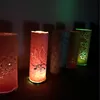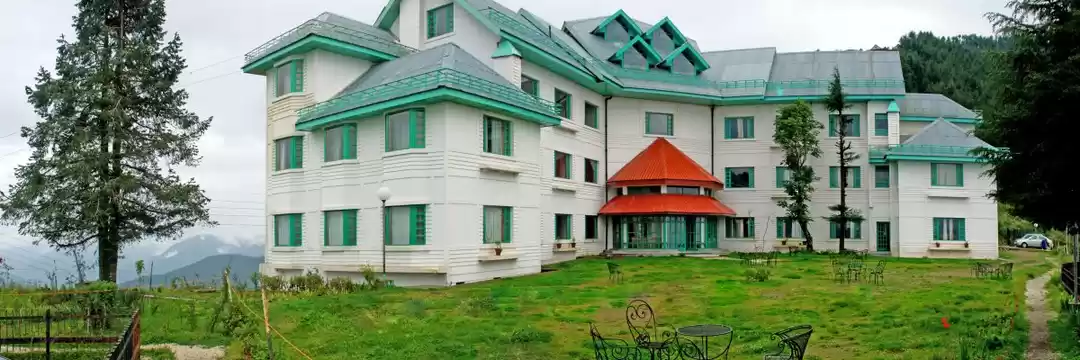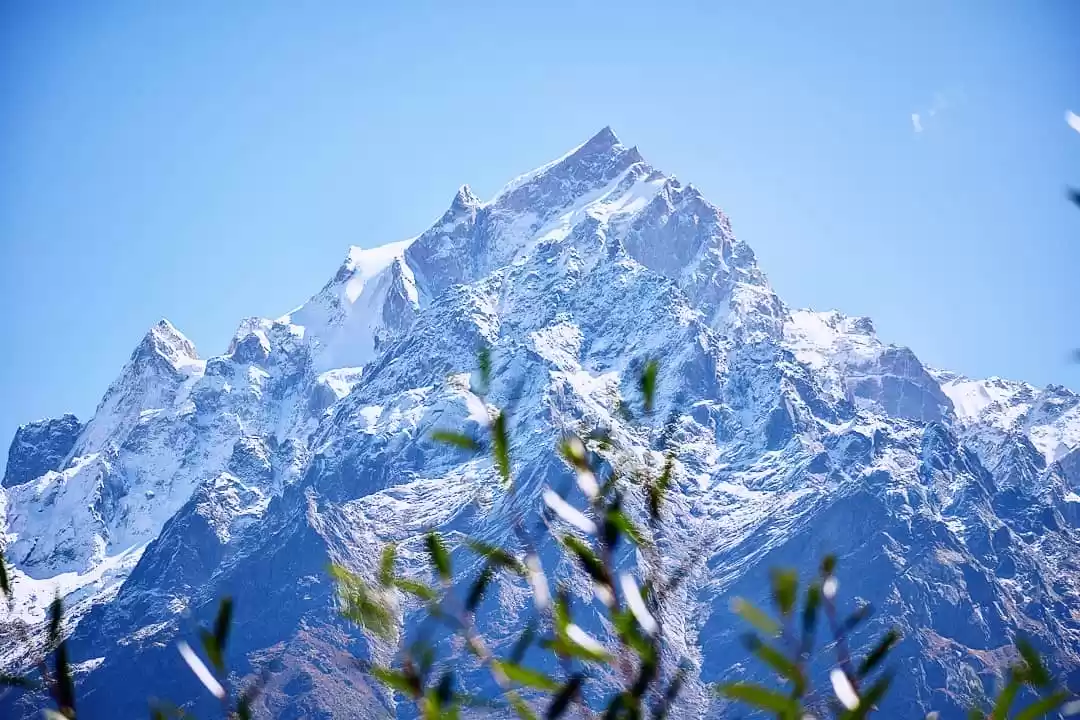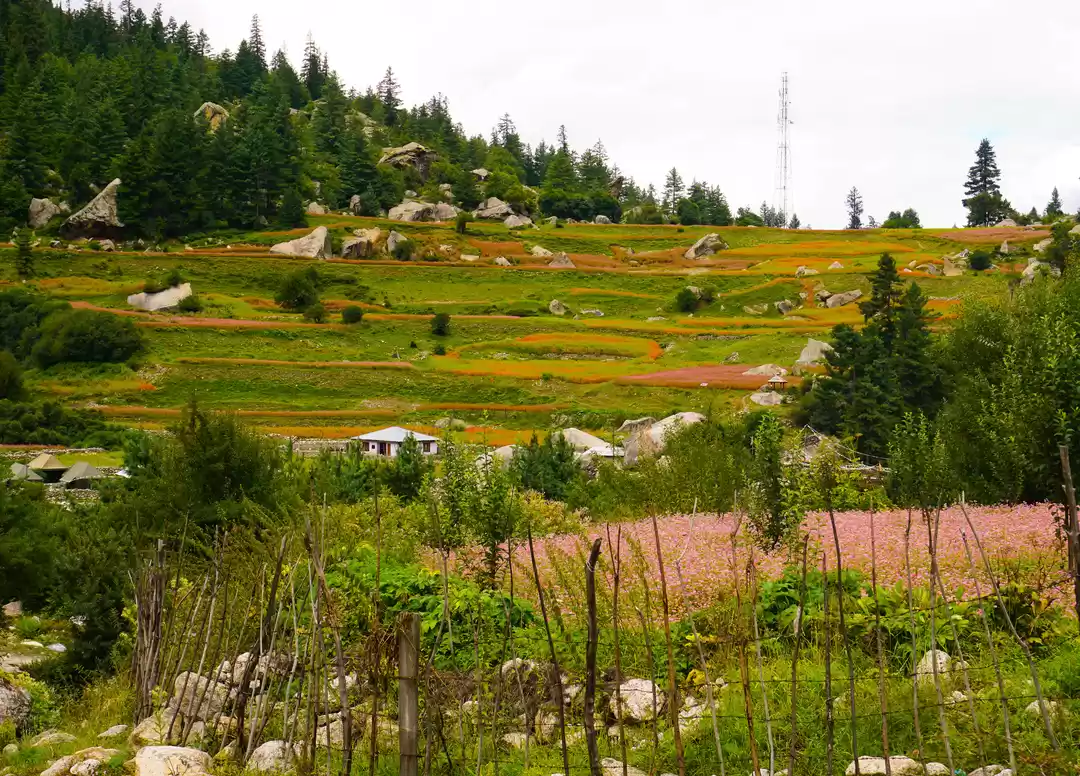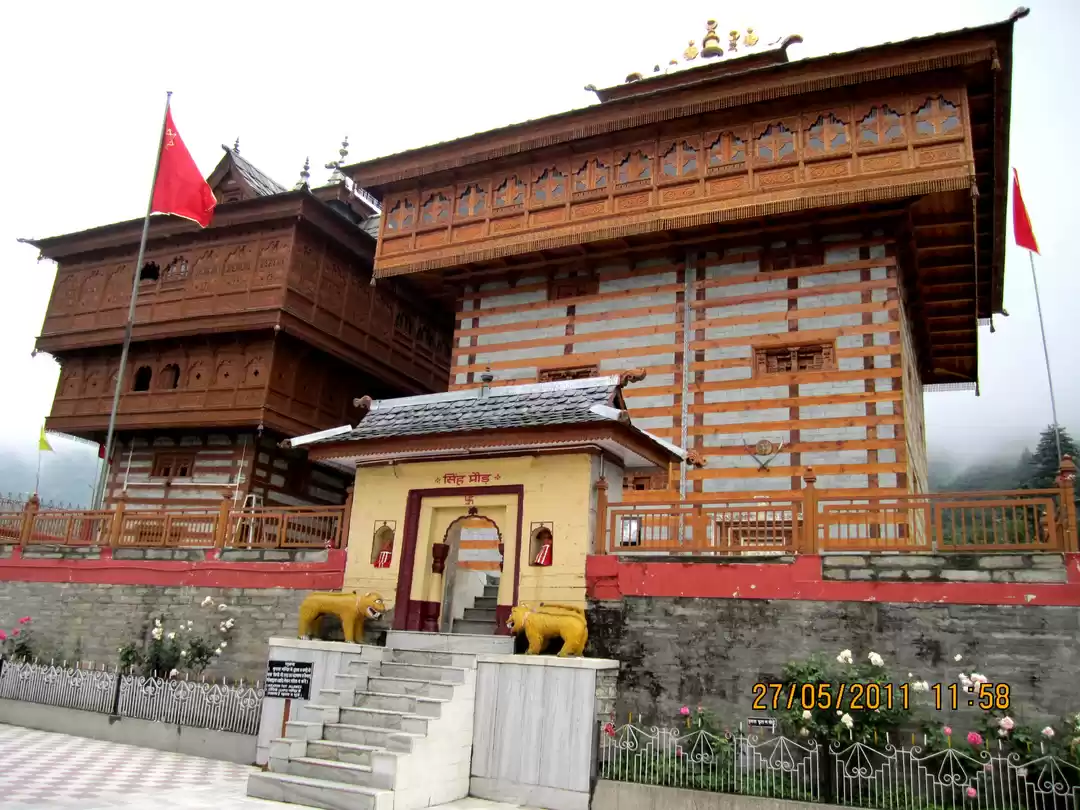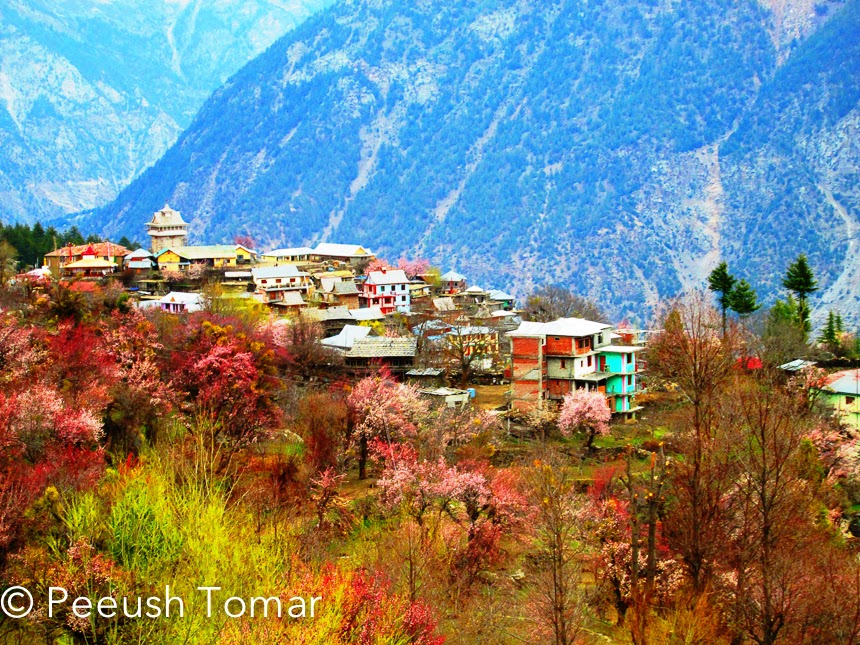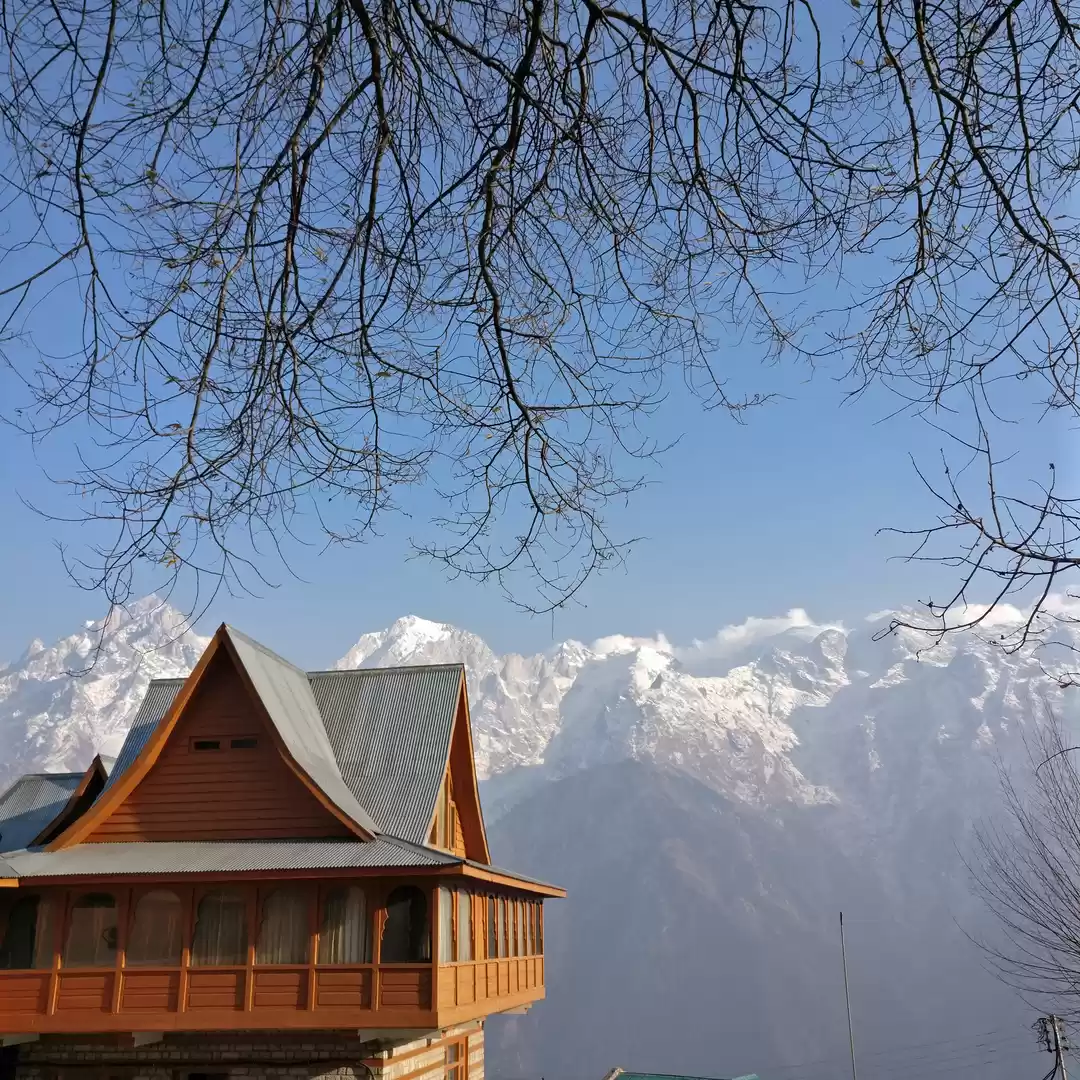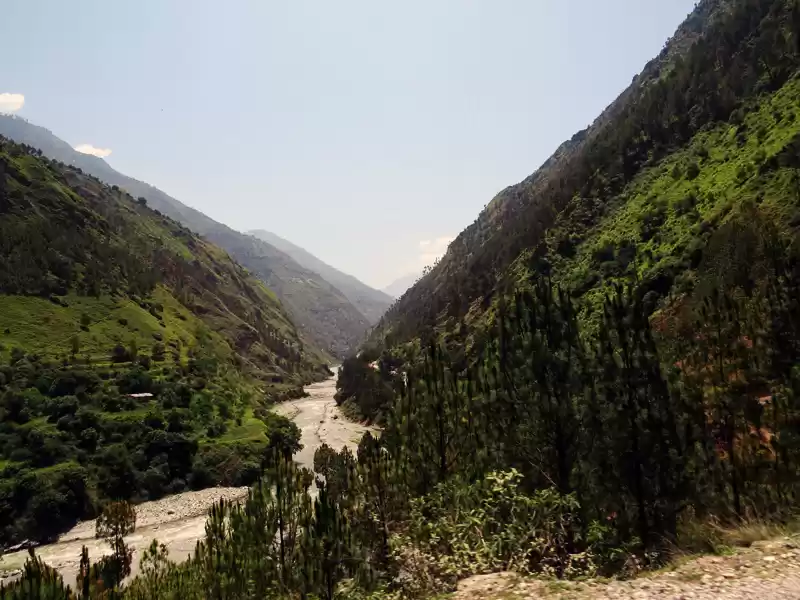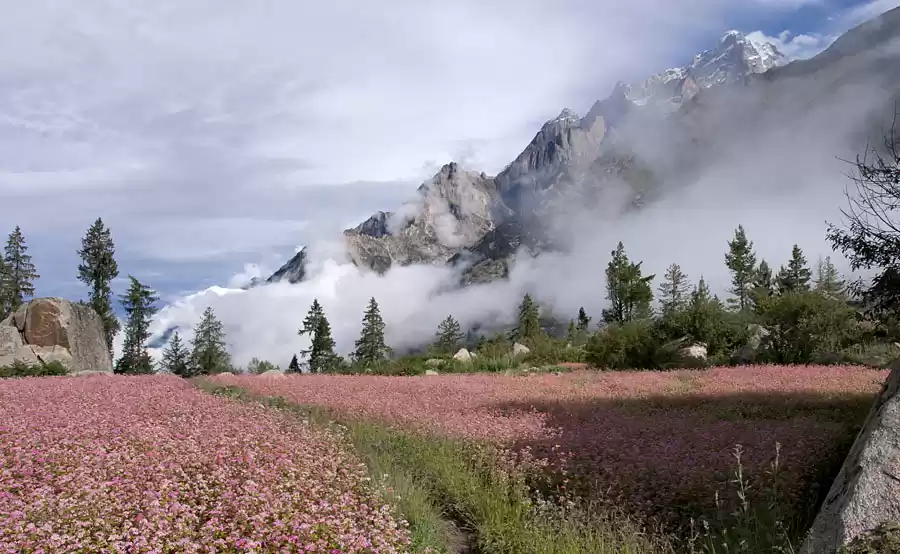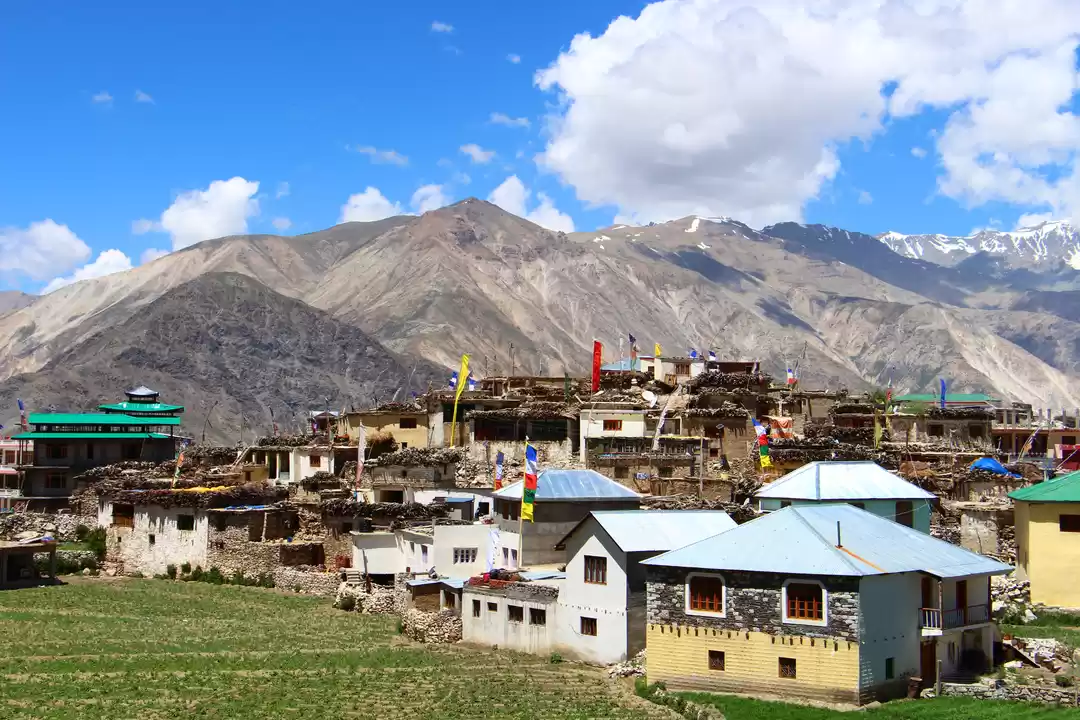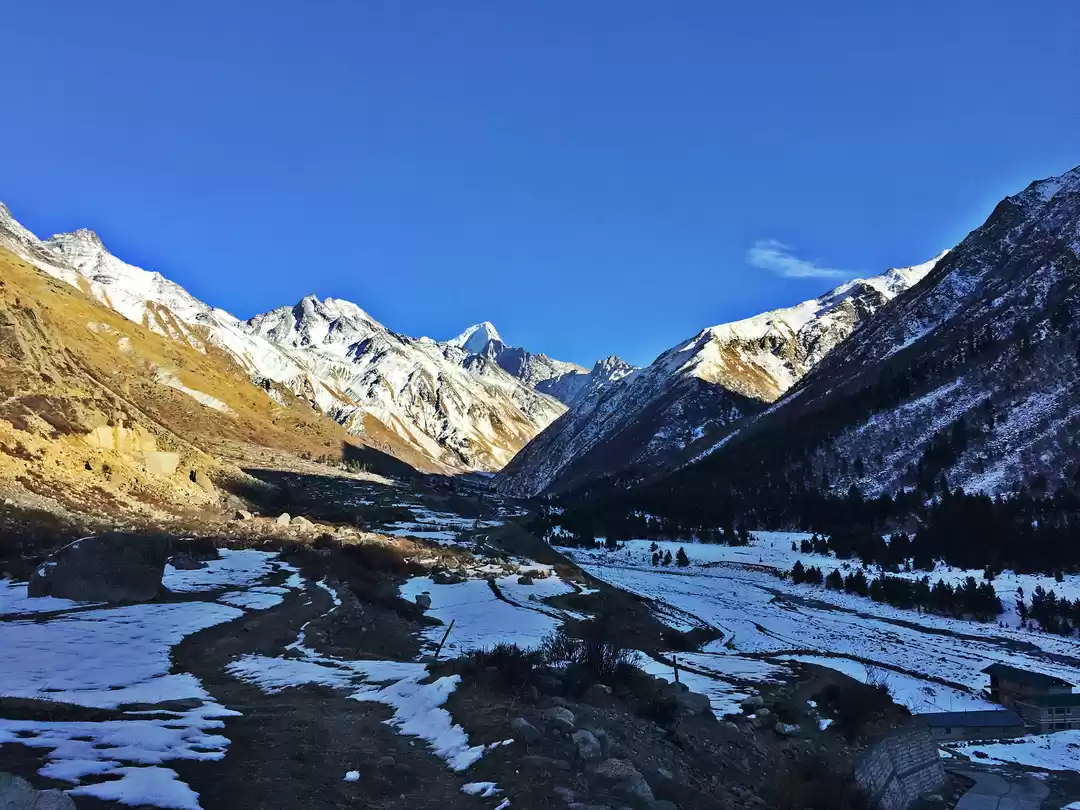
Kolkata -Delhi- Kalka:
On our first day of travel we reached New Delhi from Kolkata by the morning flight. We had to take a halt for close to 5 hours in Delhi as the Delhi Kalka Shatabdi express was scheduled to depart at 18:00 Hrs. We decided to stay in a hotel to take a quick nap and to freshen up. It was better to stay as near as possible to the Railway station, so we had booked a room at the Ginger hotel. Located within the station complex this branch of the chain of hotels is a “life saver” with basic but clean decent rooms and a commesum restaurant to cater to fooding necessities.
We reached Kalka around 9 PM. There are a number of hotels near the station . But we preferred to stay away from the din and bustle of the station area. HPTDC has a property Hotel Shivalik at Parwanwoo which is just 4 KM away from the Kalka station and is just across the HP Hariyana border on the HP side.
A quick taxi ride from the station took us to the hotel. The spell of HP started to cast on us from here itself. Amidst the dark night in Parwanwoo we could make out the diminished miniatures of the mighty Himalayas surrounding us and welcoming us in their abode. The clear night sky studded with millions of scintillating diamonds was spread like a canopy as we took a walk after dinner. There was a chill in the air which was not that prominent even in Kalka.
Kalka- Shimla:
The official timing of the much sought after Kalka Shimla Shivalik Deluxe express train is 5:20am. But after conferring with the locals and few co passengers we came to understand that the train time in reality is correlated to the arrival of the Howrah Kalka mail. Many of the passengers arriving in Kalka by this train board the Shivalik deluxe for their onward journey to Shimla. So the Shivalik deluxe gets delayed when the Kalka mail gets delayed.But still,we were advised by the hotel manager not to risk waiting at the Hotel, because in case the Kalka mail is severely delayed there is no guarantee that Shivalik deluxe would wait for it.
So,we reached the station around 5:30am. It was still dark and was a bit chilly too.
Soon a bright new morning came to greet us and we could see the foothills standing far beckoning us to start our journey.
After some more time waiting on the station bench we were convinced that the train is not going to move an inch till at least 10 O'clock as the Kalka mail was more than 6 hrs late. Even regretting the decision of coming to the station so early was not an option as it could be otherwise as well.
So the only option was to wait for those unseen, unacquainted would be co-passengers with an impatient mind and longing in the heart counting every single minute.
A Journey Down the Hills and Round the Bends:
The Shivalik deluxe express which accommodates 120 passengers is little larger than “toy-train”. It has wall to wall carpet and reversible cushioned seats with tables. A nice soothing music was playing inside the train. The wide glass windows provide a panoramic view of the surroundings as the train snakes its way through the Pines and Deodars chugging uphill covering 96 Km on its way to Shimla. It crosses 889 bridges and 103 tunnels, the Barog tunnel being the longest one. Just after the tunnel the train halts for it’s single stoppage at the picturesque Barog station at an altitude of 1552 Metres. This station is a UNESCO World heritage site along with the Kalka-Shimla railway line.
After the brief stop at Barog, the train started trailing its serpentine narrow gauge track again through lush green woods. We were served bread, egg omelets and veg cutlets with tea as part of the breakfast. But it feels that you need nothing other than your DSLR or i-Phone during this picturesque journey as the train takes sharp turns and bends crossing several brooklets and springs in its 5 hour journey.
Especially if you suffer from motion sickness while travelling in the hills this train journey will be a bliss for you saving at least the first day of your trip (which is otherwise very painful in a car).
Time moved on as the pine scented fresh breeze and the rhythmic chugging amidst that idyllic backdrop carried us to a fantasyland away from our everyday world.






Outside the Shimla station our cab was waiting (rather impatiently) to take us to the Peterhoff. Now a renowned HPTDC hotel, it was once the residence of the viceroy of India. After independence in 1947 it housed the Punjab high court and was later used as the official residence of the governor of Himachal Pradesh.
In the evening we went to the famous Shimla Kalibari.A short cab ride took us near the office of the SP of Shimla, which is one of the designated drop off point for Mall.
The walk from here to the mandir is uphill mostly and through residential areas.
The evening Arati was going on. Maa Kaali is known as Shyamala here from which the town has got the name Shimla. There is also a Shiva temple in the mandir complex. There is a beautiful view of the entire Shimla town from here with a backdrop of mighty peaks. The mandir also offers lodging and food at a reasonable rate. After offering our prayers we took a walk to our favorite restaurant at the Shimla Mall.
It was again a leisurely walk up and down through residential areas and narrow alleys. We were walking by ourselves casually without being aware that this route was part of the famous heritage walk of Shimla. It is a good idea to spend a relaxed afternoon strolling around the heritage zones of the town like the Cathedral church, GPO, the Anglican Church, the state library, Gaiety theatre and town hall.
It was almost 9pm. as we finished our dinner.The chill in the air has picked up. There were still people roaming around the mall but we had to return back to our hotel as we had a long journey ahead of us the next morning.


Shimla-Rampur-Sarahan:
We started from Shimla around 8am. and it took us almost 5 hours to reach Rampur which is almost 135 Km. It is commonly known as Rampur Bushahr as once it was the winter capital of the princely state of Bushahr. When Raja Ram Singh founded the town in the 18th century, Sarahan was the seat of the royal family from where the family later moved to the valley of Sutlej.
At an average elevation of 4428ft. today’s Rampur is a bustling town on NH22.
Due to its location on the ancient Hindustan-Tibet road, Rampur served as an important trade link between Ladakh, Tibet, Afghanistan, China and North India during the era of Bushahr regency. The town traces its old tradition by hosting the Lavi fair each year in November. It is the largest trading event in the Himalayas in which traders from Kashmir, Ladakh, Yarkandh and mainland India take part.
HPTDC has their hotel “Bushahr Regency” on NH22 about 2 KM ahead of the Rampur town, avoiding the crowded market place. There is also a nice café “café Sutlej”. Just beside the hotel flows the roaring river while the lofty green hill encircle all around. Quite a nice place for a “night halt” if you are coming from Manali via Jalori pass and heading towards Kalpa.
The restaurant serves the same HPTDC menu. At such odd hour of the day (late afternoon) we were the only guests for lunch. The service was prompt and the food was hot and fresh. The simple Dal, Roti and Sabzi had great taste.
Way to Sarahan:
The journey resumed after a pleasant late lunch. This part of the journey (Rampur to Jeori) has the finest roads. The scenic beauty enthralled our minds more and more after every turn and bend.
Occasionally we could spot small dots on distant green hills and after a few more turns and bends and some climb we were passing through the tiny village busy with day to day life. These human habitations bring the periodic change after crossing long desolate hill roads kilometers after kilometers. They seem to be tiny pots of life nestled in the vast oceans of hills.
12 Km before of Jeori the Nathpa-Jhakri hydro power project on the Sutlej cuts down the speed of the traffic due to congestion. At Jeori the road forks, and an uphill drive of 17 Km towards the right took us halfway up a mountain side at the beautiful hamlet of Sarahan.
It took 1 and 1/2 hrs. to reach Sarahan from Rampur. We had booked ourselves into the HPTDC hotel Srikhand. The hotel is just beside the famous Bhimakali temple.
The temple is a unique Indo-Tibetan wooden pagoda like structure. It is a “never to miss” in Sarahan. The motor able road ends at the hotel as it is constructed at the verge of the hill with a grand view of the entire Srikhand mountain range in front and the sprawling valley below. There is always a rush for booking this hotel. So planning well ahead is necessary.
To our utter disappointment we couldn’t see any of the peaks once we stepped out into the balcony of our room. A dense cloud of mist rising from the valleys below like a coil of vapor has covered up whatever was supposed to be there in front of us as documented in several travelogues. Quite unexpectedly the scene started to get clear and within a few minutes the ethereal curtain was drawn aside as if to gift us a glimpse of the sublime view of the entire range with the snow clad Srikand Mahadev.
Though it was pretty chilly at 5pm. in the evening, we spent a fair amount of time in the little balcony overlooking the valley to cherish that heavenly experience.
Soon darkness engulfed the surrounding. Night came in and the tall, dark cold mountains outside along with the tiny flickering dots of lights from villages remained splayed as the mirror image of the sky above.



The Bhimakali temple attaches a bit of history to Sarahan. This tranquil hamlet at an elevation of 699ft. became the capital of Bushahr regency after the royal family shifted their seat here from Kamru fort near Sangla in the valley of the Baspa River. Later when king Ram Singh shifted the capital to Rampur, Sarahan remained the summer capital. The royal family used to live in the temple along with Devi Bhimakali the presiding deity (kuldevi) of the family until they shifted to the Shrikhand view palace built a few meters outside the temple courtyard.
In mythology Sarahan dates back to the age of Mahabharata. It is believed that the land of Kinnaur was the place where Lord Shiva once disguised himself as ‘Kirata’. Local belief says that Sarahan is the mythological Shonitpur the seat of the Kirat king Banasura, an ardent devotee of Lord Shiva.
In the temple complex there are two adjacent buildings – the old resurrected temple and its look -alike a newer one built by raja Shamsher Singh in 1927.
The intricate wooden décor is mesmerizing. From inside it is the typical alternate grooved wood and stone structure with thick walls, narrow staircases and low ceilings found in buildings and temples in mountainous regions.
There is a Tibetan influence in architecture.This can be regarded as a reflection of the old trade link between India and Tibet which passed through Shalabag, near Sarahan.
Apart from the main temples there are three smaller temples within the premises-the Raghunath Ji temple, the Nrisingha temple and the Patal Bhairav temple.
There are Hindu as well as Vajrayana Buddhist statues and even statues supposedly of the Kushan era in the temple premises. Legends say the ear of Sati fell at this place and hence it is also considered as one of the 51 shakti pithas.
Presently, at the upper most level of the three storied temple the kuladevi of Bushahr estate is being worshipped as Devi Bhimakali . In the second story, Devi Parbati is being worshipped as the consort of Lord Shiva.
Puja dali is available at the small shops outside the temple. Leather items, mobiles and cameras are not allowed. These can be deposited for safekeeping in a locker. You will also be provided a cloth to cover your head.
It was early morning and there was nobody else except us and two or three aged persons who were someway attached to the temple. Barefoot we went upstairs covering our head with those colorful clothes.
Apart from the occasional gong of the bell there was an undisturbed serenity all around. Upstairs you can perform the rituals by yourself. Otherwise the priest is there to assist you in Puja.
The entire temple complex was very neatly maintained. The process was so simple and lucid, so uncomplicated and unadulterated that everything was seemingly merging into the peaceful nature around and filling our minds with tranquil surreality.
Standing amidst that absolute serenity in the courtyard of an age old temple with the backdrop of snow clad peaks of the mighty Himalayas we felt as if we were standing in front of eternity. We bowed our head in reverence to the century old legends of Sarahan that amalgamates mythology, religion, anthropology and history to create the eternal heritage of today’s India.
From Sarahan we drove down 17km. to reach Jeori again. From there we headed towards Wangtoo. Slowly the terrain began to change as we were approaching the interior parts of Kinnaur leading to the rain shadow areas of the Spiti valley.The lush green hills of Shimla made way for the awe inspiring rocky, brown and barren hills that are typical of Kinnaur. Here and there the huge hanging chunks of solid rock was forming gateway to the mythical abode of the heavenly musicians.
Our driver stopped at a local temple(Taranda Devi) along with couple of other vehicles to seek blessing from the goddess Sherawali before moving further ahead.
High up on the hills there were some human habitations scattered here and there with some scanty pastures. If observed closely, you can make out a thin thread like line stretched across the hills. These are walkways of the local people, mostly tribal, who seldom come down. They grow medicinal plants and some rare varieties of mushroom on the hill side. They are also said to grow narcotics. But the police do not bother to go up the extreme places to enquire.
They rarely come down to nearest market places to sell their produce. We also saw a rudimentary cable carriage arrangements, which they use for hauling their goods up the hill while they climb on foot.
Wangtoo was only 35km. from Jeori. Still it took almost two and a half hours because of the extremely precarious condition of the road. Here is an example of a man-made disaster in the making. The construction of several tunnels through the mountain sides for the Karcham Wangtoo hydroelectric power project has destabilized the entire area. We witnessed an entire mountain side crashing down in a landslide. There were villages on these hill sides which have now been evacuated. Remains of these villages come down with the debris of the slide. A land and its people sacrificed for modern development. The project may be a necessity for the state and the country but its harsh impact on the delicate ecosystem is scattered like scars everywhere.
The river here has turned muddy and flows with a vengeance, augmented by several artificial flow in tunnels.The fresh mountain breeze is overloaded with dust and diesel fumes.
After a short stop at the Wangtoo Bridge for security checking we proceeded towards Tapri.
The narrow stretch of land between the black hill side and the river can hardly called a road, with boulders littered all around. Our car toiled up the dusty path.
We reached Tapri at around 10 o clock only to find the main road completely closed due to yet another landslide caused by the project work.
Tapri was a small settlement with few shops. We replenished our stock of dry snacks and started on an alternative route created by the Border roads organization. It was a temporary road build to let the stranded vehicles pass. The road went down almost near the river bed. The Sutlej was flowing only a few meters below. We crossed the belly churning stretch and reconnected with the main road and started to climb again.From here the road improved, and in every turn and bend we could see glimpses of the snow-clad mountains. The Ruldung range was playing peek-a-boo and was cheering us up.
After a very strenuous ride we reached Karcham.
From Karchan the road bifurcates. After crossing the river, the road at the right hand side runs along the Baspa river to reach Sangla valley while road towards the left continues following the boisterous Sutlej.
From Powari the route takes a sudden left turn and starts climbing uphill.To our great relief,this road was smooth and well maintained. After a few more sharp turns we found ourselves hundreds of meters above the river. The tall green pine trees appear again alongside the road.Then suddenly after another sharp turn the breathtaking view of the entire Kinnaur Kailash range unfolded before our eyes. Its enormity made us spellbound and it was impossible to take our eyes away from it for even for a single moment. With every turn it came closer and closer. We felt like we could even touch it with our outstretched hand. Never before have we seen these gigantic white peaks so close to us. At the end of climbing seven kilometers we reached Recong Peo, the district headquarter of Kinnaur.
At an altitude of 2290m, Recong Peo or as locally called Peo is a typical hill town with life buzzing in the local market places, streets and bus stops. There are a few government and other cooperatives that have shops selling authentic local handicraft, Shawls of Kinnaur, Rugs and ethnic jewelry.
For Kinnaur apples and a huge variety of exotic spices and dry fruits the cooperative market is a “not to miss” stop on the way to Kalpa. But the shopping does not end without buying Chilgoza.This is actually the major cash crop of the region. At an elevation between 1800m. to 3350m. grows a special type of Pine -“pinus gerandiana’-locally known as Chilgoza. The plant is native to the north western Himalayas from Afghanistan, Pakistan and India.
In India it is only found in the Kinnaur region. The edible nuts of the pines commonly called as ‘neja’ or ‘chilgoza’ is the speciality of Kinnaur. It is quite expensive, however the cooperative shops sell them at a fair price. The same thing will cost 2 to 3 times if purchased in cities like Kolkata or Delhi.
From Recong-Peo it was another half an hour climbing through apple and apricot orchards, gardens of medicinal plants and grape vines to reach Kalpa.We passed few slate roofed Kinnaur cottages, women busy drying apricot and apple wedges and children returning back from school and we knew we were approaching Kalpa.
The HPTDC hotel Kinnaur Kailash as the name suggests offers a 180 degree view of the entire Kinnaur Kailash mountain range. The stunning view kept us mesmerized for a long time.
We had reached quite early in that season and the staff were struggling to get all the services of the property ready.As the initial wow of the place slowly settled down inside us, we were faced with the reality of having arrived at a hotel where half of the staff have not joined yet and many of the services are running at a bare minimum necessity.However, the staff (some of whom we knew from our last trip) as always were very warm and welcoming. The basic hot bowl of Maggy was almost the best food we have had.The staff put in their best effort to ensure that we were comfortable.
We booked the Kinnaur Cottages. These are old Kinnaur style houses that are just above the new hotel block. The rooms are huge with an attached dining room. But they are old too and some parts do look like they will fall down.
But still the rusty feel blends beautifully with the surroundings.It was already dark by the time we unpacked and settled down. After a pretty early dinner we called it a day.




In the morning we walked down to the old village of Chini. Since 1960 the entire area covering Chini and Kalpa has been renamed as Kalpa. The hamlet of Chini was very important for its position on the Indo-Tibetan trade route. There are a couple of old Buddhist monasteries including the Hu-Bu-Lan-Kar gompa founded by Rinchensang Po as well as Hindu temples like the “Narayan-Nagini” temple.
We walked down steps in narrow alleys flanked by Kinnauri cottages with their slate roofs. We passed few small shops selling basic supplies and a very old post office. We walked casually down the alleys which open into a large field. The field belonged to the local school. There was a temple at one side of the field which had the typical mixed hindu-buddhist architecture. The pagoda style architecture with intricate ornamental wood work at the main entrance of the temple intrigued us. The temple was closed and we could not find anyone around the area to ask about the temple. We spent some more time around the desolate temple courtyard with the backdrop of the mighty Kinnaur kailash range.
This place was the lower end of the hill, on top of which was our Hotel. From our hotel the view of the Kinnaur Kailash range was breathtaking. But now from a lower area the enormity of the peaks was more prominent.
While we were lost in this panorama, the weather started changing very rapidly. The dark clouds around the high peaks and the fading light was creating an eerie backdrop. We felt it was high time to start the walk back to the hotel. This time rather than walking through the houses and alleys we decided to take a longer route through the apple orchards.
As we turned back we found that the bounty of nature bestowed upon the Kalpa village has its own beauty which was by no means lesser than the lofty snow covered peaks. The trees in the orchards were in full bloom. With the lush green background of pines forests it looked as if Kalpa had wrapped on an ethereal veil of fine white and pink gossamer around herself.
It started to drizzle on our way back. A dark storm was bearing down from the cliffs. We knew that it was a snow blizzard that was going on there on those realms of eternal cold and silence.
We awaited on the porch of another small temple for the rain to stop.
In the evening we found that an enigmatic veil of dark clouds and white mist is covering up the entire range gradually and forming a strange halo. It looked like something supernatural. We had no idea what was in store next. The sight was eerie and majestic at the same time. It was still raining when we came back to our rooms after dinner.







The morning started with fine snowflakes settling down on steps, the ground, branches. Within a couple of hours, all that was green or brown was covered with thick layer of white snow. Soon the path from our cottage to the main building and restaurant got buried. We were enjoying every bit of the moment. It snowed all day long and the roads became inaccessible.
We had a prior booking in Sangla. But the very idea of driving through those treacherous stretches from Powari to Karcham seemed suicidal.
While travelling,we have often had to make changes to our itinerary for unforeseen reasons, but this time we were happy to do so.The mountains and the hamlets all remained obscured by the white veil of snowfall for the entire day. Then at the verge of the day’s end, when the snowfall stopped, and the mist slowly disappeared, the mighty peaks of Kinnaur Kailash reappeared before us like magic. The scenery was like an artist’s painting of White Mountains on the canvas of a bright blue sky. The peaks have now been covered with heaps of fresh snow with the scarlet rays of the setting sun glistening on them.






Next day we were greeted by a bright sun. There was azure blue sky over us and everything on ground was still covered with white snow. The sunlight reflected on the snow was almost blinding. With the occasional thud of the melting chunks of snow heaped on branches, on the slanting roofs and with the silent melting of icicles,our heart was sinking into a deep melancholy as it was time to leave Kalpa.
With heavy hearts we made our way towards our car which was still covered with at least 6 inches of snow.
We looked up towards the Kinnaur Kailash to pay our last homage to Lord Shiva before bidding adieu to Kalpa. The famed Shivling on top was shining with the same brown hue under the bright rays of morning in the same way as it looked when we first saw it in the afternoon of the day we reached Kalpa. May be the change of color is a myth, or maybe it is an allegory or may be it happens with some particular combination of weather and light.
What we felt in our hearts was a feeling of deep gratitude for fulfilling our long cherished dream in such a memorable way.
As we were leaving the pristine village and descending towards the valley we were almost leaning out of the window of the car to frame one last view of the majestic Kinnaur Kailash.
We knew, like every previous trip after a few days of returning, these snaps stored in our phones and memory cards would give way to chronicles of everyday life. But we also knew whenever we would turn to them after a day’s toil in our fast paced lives in the city, they would bring back those unbounded joys like fresh minty breeze of the mountains.

